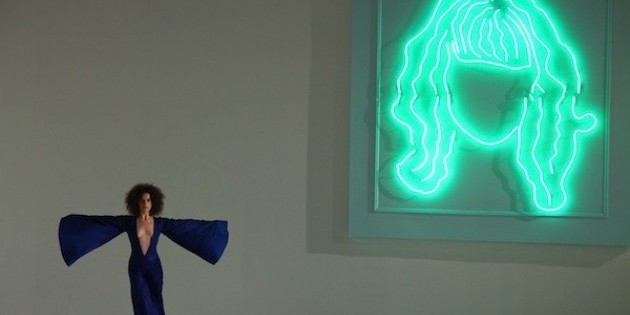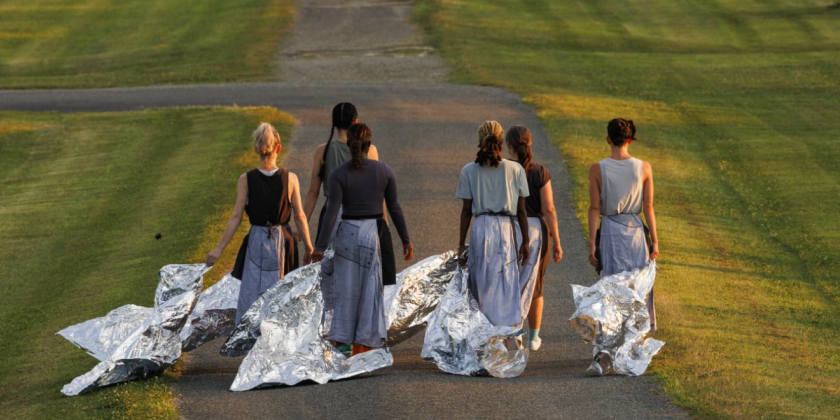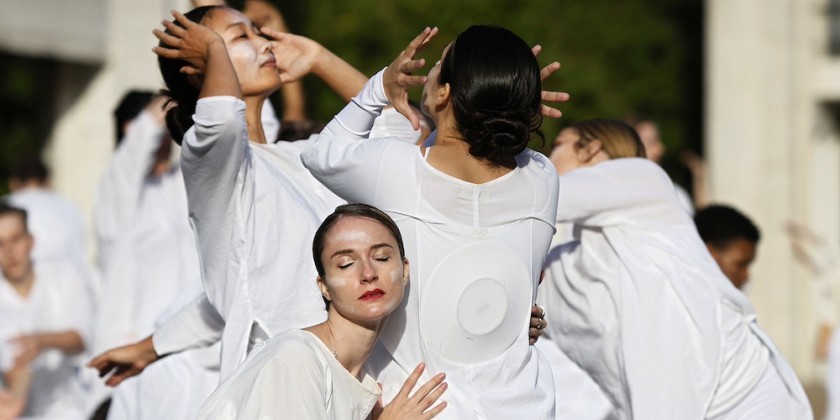Five Rules for "Going Gallery"

Five Rules For Creating Movement Based Work for the Gallery / Museum Setting
.jpg) |
| Brittany Beyer , Associate Editor for The Dance Enthusiast |
I admit it. Like everyone else, I have been bitten by the bug.
For the past few years I have been constructing a multidisciplinary artistic experience for a gallery space in my head. My imaginary work consists of a few conceptual art pieces, some video installations, and a time-based performance. I won’t give anymore away right now. I would like to surprise you at my future opening. Still, while you are waiting, I thought I would share some of my thoughts on best practices for creating museum quality movement work.
A Bit of Personal History:
I began considering dance in galleries and museums in earnest when I was pursuing my Masters degree at New York University’s Tisch Art and Public Policy Department. Two important professors I met there influenced me. Karen Finley was an amazing guide. She spoke of developing skills which crystallize an artistic idea through a series of research exercises. Through a semester of exercises, including sourcing inspiration from the library, scientific information, and even fairy tales, each student matriculated with a unique project ripe with their own point of view.
Another inspiration for this mental exercise came from a class entitled, “Choreographing Things” with the formidable Andre Lepecki. The heavy philosophical thought of Heidegger, Derrida, Baudrillard (among many others) was used to extrapolate what happens when “things are found thinging,” or why certain objects have the tone, outcomes, and possibilities they do when they interact with others under certain conditions.
It was intense, (as philosophy is) and I was mesmerized by the the chance to explore why and what can be done in certain spaces, how situational interactions are created by objects that are almost “attracted” to each other, and ultimately, what meaning is conveyed when a moment between objects is played out.
Now, without further ado, here are my five rules for creating movement based work in galleries. I believe If you master them, you will have a great chance at creating a compelling piece for a promising new audience. Good luck!
The Rules:
1. Do Some Art History Digging -- and Know Who Is Performing Performance Art Today.
I suggest looking further back in the dance/artistic past than our beloved Judson Dance Theater. Performance Art: From Futurism to the Present is a wonderful start to this
There are reasons the Dadaists and the Judson Church innovators emerged during their respective time periods.
exploration. RoseLee Goldberg, the book’s author, is a leading expert on the artistic medium of performance art. Within the last decade she has grown the biennial of performance art, Performa, into a global event.
A general knowledge of sociopolitical history adjacent to important artistic movements is also very important. There are reasons the Dadaists and the Judson Church innovators emerged during their respective time periods. Their art work reflected important moments of social change occurring in society. The creation of art which explores new boundaries, values, and current thoughts can help open up a space for people to consider and deal with new ideas.
Then, there is the task of being informed about who is creating gallery work today. See the work that is currently crossing the moving arts divide. Almost every modern art museum in New York City (including Museum of Modern Art, Museum Arts and Design, The New Museum) is supporting movement based work, and many galleries are featuring it as well. Those who are reaching the level of large museum showings are few, but Sarah Mitchelson, (winner of the 2012 Bucksbaum Award at the Whitney Biennale) Michael Clark, Tino Sehgal, Marina Abramovic, (who is opening up an arts center in Hudson, NY dedicated to furthering performance art) have shaped the field.
The average viewer in the gallery setting will be transient, walking through your performance setting and seeing only about 45 seconds of your work.
If you want to have your work deliver a message which is similar to a sculpture or painting that might be placed adjacently in the room, you need to design your movement palate with a strong primary image in mind. 2. Contemplate The Design of The Gallery / Museum Space. It’s Not a Black Box or a Proscenium Stage.
In New York we already dance in “alternative spaces.”Danspace Project , The Chocolate Factory, Judson Church for example, are not proscenium or black box spaces. So we are already one step closer to working in gallery spaces or in a specific room of a museum. Still, some dance creators make the mistake of not considering the non-traditional spaces when they create the work. This makes for a weaker end product.
On Monday, September 17th this year, Performa hosted a conversation at Judson Church about dance in the gallery/museum context. For this conversation, Ralph Lemon, the prolific experimentalist choreographer, who also has a well developed visual art practice, spoke on the panel as the artist to counterpoint the media specialist (Artforum contributor David Velasco) and the museum curator. (MoMA PS1 curator Jenny Schlenzka)
Lemon elaborated on the development of his work in the gallery setting, and how carefully his concept has to shift along with the content shown. He spoke in depth about the difference of “value” (monetary, interest generating, street cred, etc) in this new space versus the traditional theater. Lemon also noted the constraints placed on the work by performers who are literally not able to leave the space or retain a “safe” distance to the viewer places. Lack of lights and the color of the walls also changes the feeling of the work.
3. Create a Clear Idea or Image for The Gallery or Museum Space. Narrative Is For The Theater.
Think about it this way: the average viewer of in the gallery setting will be transient, walking through your performance setting and seeing only about 45 seconds of your work. If you want to have your work deliver a message which is similar to a sculpture or painting that might be placed adjacently in the room, you need to design your movement palate with a strong primary image in mind.
An excellent example of what I like to call “one-note exploration” is the exhibition of Marina Abramovic’s retrospective at MoMA in 2010. Each piece (Imponderabilia, Relation in Time, Point of Contact and many more) was portrayed as a living sculpture. Abramovic’s pieces were stamina tests in which the participants held their position for hours on end, allowing the audience to contemplate the action for different periods of time.
Another option is to guide someone through an experience which is both personal and unique to each visitor. This type of exploration is difficult and needs to be carefully planned and crafted, but if this is your vision my hat is off to you.
In his recent Guggenheim installation pieces, Tino Seghal brilliantly crafted such an experience. In “This Progress” a museum goer was led up the Guggenheim’s winding staircase while guided by multiple participants. Each visitor was part of a unique journey in the name of contemplating process and progression.
Whatever you do in the end, specificity and a level of investigation that your audience can connect with is crucial.
4. Leave a “Residue” Behind.
If you cannot explain the “what and why” of your piece, you do not have a chance at getting the visual arts community to understand what you are doing...
Artists who show work in the visual arts world can explain the influences on their work, validating why they belong in the canon of art history.
It is important that the dance community bring historical context back into the discussion of our creative process.
Unlike the theatrical stage, where everything disappears as soon as the players leave the stage and/or the curtain drops, there is no “lights out” finality to the museum experience. The question becomes then, how to deal with this.
It can be utterly compelling if your performance piece leaves some tangible object as an after effect for the gallery space. That “residue” in a most direct way becomes an art work itself. Those who see the action will have a deeper sense of attachment to this piece left behind, and those who only are able view the “residual” piece independently can experience your work conceptually.
Take, for example, Trisha Brown’s body drawing pieces, which was also the impetus for Tony Orico’s drawings. The drawings have their own resonance as an visual art piece.
5. And Finally, My Non-Verbal Friends, Back Up Your Work with Your Artist Statement.
I am not the only person to believe that a good portion of the dance field has become slothful in explaining their abstract creations. Yes, the enjoyment of a dance piece for the informed audience member is great experience, but for the uninformed viewer it is imperative to explain what you are trying to do in some form. This is especially important when approaching gallery work because the visual arts community traditionally has done an excellent job of insisting that their artists explain the thoughts behind creating their conceptual work. If you cannot explain the “what and why” of your piece, you do not have a chance at getting the visual arts community to understand what you are doing.
Additionally, artists who show work in the visual arts world can explain the influences on their work, validating why they belong in the canon of art history. This exercise has disintegrated in the dance community. (ballet is an exception to this statement) Articulating contemporary dance gets murky once we start talking post-post-modern.
It is important that the dance community bring historical context back into the discussion of our creative process.
Take a look at some of the ways visual artists talk about their work while redefining your process. This can be a difficult task, and many people suggest having at least a few people constructively critique your work. For dance makers, bringing to light recognizable influences to your creative exploration is crucial. Are you responding to something in your life the viewer might relate to? Whatever your impetus may be, expressing it as clearly as possible with your audience is key.
For a little more help, here is a like to Sarah Schmerler’s website showing some examples of good work sample statements, and a little more help from BmoreArt.
I bid you a great creative journey, and wish you the best luck in bringing the power of the moving body to a broader audience.













